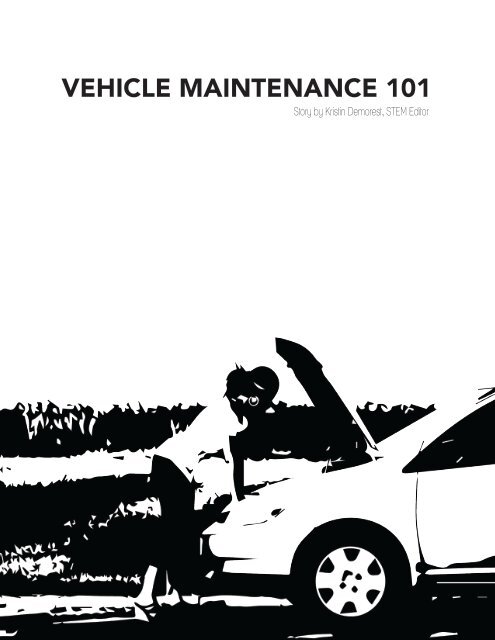Valkyrie Fall 2018 - Issue 1
Create successful ePaper yourself
Turn your PDF publications into a flip-book with our unique Google optimized e-Paper software.
VEHICLE MAINTENANCE 101<br />
Story by Kristin Demorest, STEM Editor<br />
Have<br />
you ever gotten a flat tire after hitting a<br />
curb on campus? Or possibly had your car battery die<br />
on the side of the interstate trying to get back home<br />
for Thanksgiving break? Maybe you’ve run out of gas<br />
after going a little too far with your gas light on. These<br />
things may not have happened to you yet, but are all<br />
very common issues college students have with their<br />
vehicles. Whether your parents live 20 minutes away<br />
or 12 hours away, it’s likely that they don’t take care of<br />
your car maintenance anymore now that you don’t live<br />
at home. Some college students with vehicles might be<br />
able to tell you how to change the oil in their car, but<br />
would be hard pressed to actually locate the oil filter.<br />
You may not even know that your car has a spare tire<br />
and a car jack in it already. Being a safe driver means<br />
that you know how to safely maintain all the parts of<br />
your car in case of an emergency. Sure, you might<br />
know the exact location of the closest Jiffy Lube, but<br />
knowing how to take care of your car in an unexpected<br />
situation will save you time, money and the embarrassment<br />
of having to call your parents or the police when<br />
your car is broken down in the middle of the night.<br />
Here are a few basic things you should know about<br />
keeping your car in check.<br />
One end-all-be-all save is to have some sort of road<br />
side assistance service, like AAA. Many car insurances<br />
will include road side assistance, but you should always<br />
check and know if your particular insurance does. If<br />
it doesn’t, be sure to invest in one. Even if you never<br />
have to use it, the first time you do will make the small<br />
monthly payment worth it. Other small precautions<br />
you can take include taking your car to get monthly<br />
tune ups, getting your tires rotated regularly and making<br />
sure to get your oil changed by the recommended<br />
date. Keeping small emergency items like a flashlight<br />
and rain poncho will make your life easier in case of an<br />
emergency. The important thing to remember is that<br />
emergencies can happen to anyone and anywhere. It<br />
never hurts to be prepared. You may not be a licensed<br />
mechanic, but you can prevent your car from having to<br />
go see one.<br />
Changing a tire. Many cars made after the<br />
year 2000 come equipped with a spare donut tire and<br />
a jack kit. The spare tire may be located underneath<br />
the car, or under a false floor in the trunk of the car. It<br />
will be secured with bolts, which you will have to undo<br />
with the long, steel lug wrench (which looks like a big<br />
metal L) which is usually kept with the tire. Before<br />
doing anything to your tire, make sure you are in a safe<br />
area, as far away from heavy traffic as possible. Turn<br />
your hazard lights on. First, take off the hubcap covering<br />
your tire. The hubcap may or may not be secured<br />
down by bolts, if it is not, you can pop off the hubcap<br />
with the lug wrench. If it is, use the lug wrench to<br />
take off the bolts, just like you did when taking out<br />
the spare tire. Then you will remove the lug nuts from<br />
the tire. Once you have the tire free, you’ll have to jack<br />
the car up, and no, you don’t have to have super-human<br />
strength to do it. Make sure your vehicle is in park, and<br />
always use your emergency brake to ensure that your<br />
vehicle won’t roll while changing the tire. You’ll place<br />
the jack underneath the side of the vehicle near the flat<br />
tire, and make sure the side of your vehicle rests firmly<br />
on the jack. Use the lug wrench to crank the jack up<br />
until the tire is about six inches off the ground. Never<br />
place any part of your body under the raised vehicle.<br />
Remove the flat tire. Grab the tire firmly by its treads<br />
and pull straight out. Set the tire on its side so that it<br />
doesn’t roll away. Mount your spare tire on the bolts,<br />
making sure the tire is pushed as far back onto the<br />
bolts as it will go. Place the lug nuts back on the bolts<br />
and tighten them with the lug wrench. Lower the vehicle<br />
back down and remove the jack. Double check that<br />
all of the lug nuts are as tight as they can be. Replace<br />
the hubcap. Return all of your materials to your car. A<br />
spare tire is not designed to run for more than about<br />
100 miles, some for less, so be sure to take your car to a<br />
mechanic and have it replaced as soon as possible.<br />
Jumping your car. A dead battery can<br />
happen anywhere and everywhere, even if your car is<br />
newer, running just fine, and even if you don’t leave<br />
your car running for a long period of time. Jumper<br />
cables are typically not included with a car, but are<br />
usually priced below $20 and are a good investment.<br />
You will need another car to use jumper cables. Make<br />
sure that both cars are off and in park. Open your hood<br />
and locate the battery. It will have a positive and negative<br />
terminal, which should be labeled with large positive<br />
and negative signs on them. Take the red clip on<br />
one end of the jumper cables and place it tightly on<br />
the positive terminal of the battery. Take the red clip<br />
on the other end of the jumper cables and place it on<br />
the positive battery terminal of the other car. Attach<br />
one of the black clips firmly to the negative terminal<br />
on the battery of the other car. Attach the black clip on<br />
your side of the cables on an unpainted piece of metal<br />
on your car that is not near the battery. Start the other,<br />
working car and let it run for a few minutes. Then, try<br />
to start your car. If it doesn’t start, turn off your car,<br />
wait about five minutes, and try again. If it does start,<br />
leave your car running. If the next time you try to run<br />
your car it doesn’t work, it is likely that your battery<br />
needs to be replaced.<br />
12 STEM<br />
13














